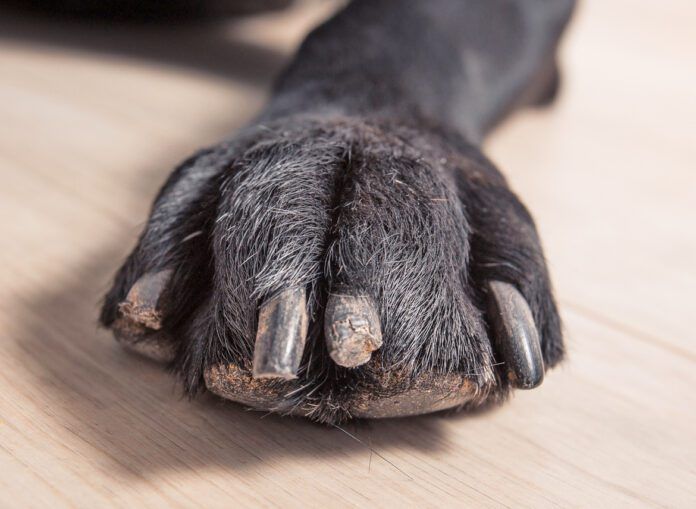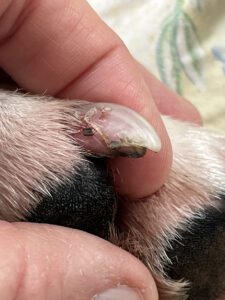
Dog nails splitting, tearing, peeling, or breaking can occur at any age, and they’re no fun for dogs who limp in pain, bleed, lick, or chew their damaged nails, or simply hurt. Split nails disrupt a dog’s coordination, interfere with walks and play dates, and can become infected. For an overview of the best treatment of nail splits and infections, see “Broken or Split Nails,” WDJ December 2022. Here’s how to help prevent this problem from happening in the first place.
Keep those nails trimmed
Too-long nails can become brittle and prone to injury, including snags on carpets, furniture, and other surfaces. Long walks on surfaces that wear the nails down, regular trips to the groomer, and learning how to use clippers or a Dremel rotating nail grinder all help prevent splits. See “The Importance of Trimming Dog Nails,” WDJ April 2016.
Prevention through nutrition
Nails take four to six months to grow, so upgrading your dog’s diet won’t produce overnight results. Be patient, though, because nutrition is a proven long-term strategy. As Amelia White, DVM, DACVD, explains in “Why are my dog’s toenails breaking?” (VETzInsight, June 2018), “The most common reason your pet’s nails are too brittle is that there is a nutritional deficiency somewhere.” The following changes to the diet and/or supplements can help prevent your dog’s nails from breaking and splitting.
- Improve your dog’s protein sources. As canine nutrition expert Mary Straus (dogaware.com) explains in “10 Healthy Additions to Your Dog’s Dry-Food Diet,” animal-source protein such as eggs, meat, fish, and dairy products support the immune and central nervous systems, contribute to wound healing, help build lean muscle, and are required for skin, coat, and nail health. In general, added foods should represent only a small portion of the calories your dog consumes. “Replacing more than 25% of the calories from a commercial diet with fresh foods, treats, and chews risks seriously unbalancing the overall diet, unless care is taken to balance the added portion,” she says.
- Use biotin to strengthen nails. Biotin (Vitamin B7) supplements are given to dogs to treat thinning hair, brittle nails, scaly skin, skin lesions, a dry and dull coat, and hair loss.

A natural way to correct a biotin deficiency is with foods that contain it, such as liver, kidneys, and other organs from beef, pork, or lamb, and poultry organs or eggs. However, as Straus notes, the low amounts of biotin in fresh foods are less likely to improve skin, coat, and nails than supplements can.
Straus says, “For dogs with minor issues, I would add fresh foods (organs and eggs) to the diet, or consider a B-complex supplement. For dogs with severe nail problems, I would consult a vet to rule out other causes and then, if biotin was appropriate, try megadoses for at least 6 months.”
Daily megadoses were used in one small study (pubmed.ncbi.nlm.nih.gov/2602924/) that found the supplement helped more than 90 percent of dogs with skin and coat problems. The dosage used worked out to 1.5 mg for a 10-pound dog, 3 mg for 25 pounds, 5 mg for 50 pounds, and 9 mg for 100 pounds. Straus recommends using human-grade biotin-only supplements.
- Fish oil can help nails. Fish oil is best known as an effective treatment for canine arthritis, but it is also recommended for brittle, broken nails. Fish oil’s omega-3 fatty acids contain eicosapentaenoic acid (EPA) and docosahexaenoic acid (DHA), both of which are associated with canine skin, coat, and nail health.
In a small 2014 clinical trial reported in the Swedish journal Acta Veterinaria Scandinavica, dogs with symmetrical lupoid onychodystrophy (SLO) were treated either with the immunosuppressant drug cyclosporine or with fish oil that provided 35-40 mg EPA+DHA per pound of body weight once daily for six months. The study concluded that cyclosporine and fish oil appeared to be equally effective.
Most fish oil is manufactured from cold-water fish such as salmon, sardine, or anchovy. Introduce fish oil gradually so your dog tolerates it well, using an amount of fish oil that provides 10 mg of EPA+DHA combined per pound of body weight daily for healthy dogs, or up to 30 to 40 mg per pound for dogs with health issues.
To assure quality in sourcing and manufacturing, look for certification seals from the National Animal Supplement Council or the International Fish Oil Standard.
- Collagen supplements might help, too. Collagen, the main structural protein found in skin and connective tissues, determines the strength and elasticity of hair, bones, nails, and teeth. As dogs age, their capacity to produce collagen diminishes, making them more susceptible to injuries, painful conditions of the bones and joints, and poor skin, coat, and nail health.
Lost collagen can be replaced through supplementation, which can help a dog restore and maintain healthy, moisturized skin, a soft and shiny coat, and strong nails that don’t split or crumble as they grow. Fresh animal proteins contain collagen as do bones and tendons. Giving your dog bones to chew or feeding bone broth can help, as can collagen supplements, which are widely sold. The recommended daily dose for dogs is 8 grams of collagen per 25 pounds of body weight.
Skip the Super Glue and brush-on nail hardener
Nail-hardening products designed for human use are not recommended for your dog’s nail splitting, and neither is Super Glue, which can cause swelling, pain, burning, and infections if applied to split or broken nails.
Moisturize toes to strengthen nails
Conditions like cold weather, low humidity, and exposure to salt and ice-melting chemicals make winter a difficult season for canine nails, so do what you can to protect your dog’s feet when it’s icy outdoors.
Products that protect a dog’s paws like Musher’s Secret and similar combinations of natural waxes and oils help prevent nail splits by moisturizing nails and reducing brittleness. Check your natural foods market for herbal salves that contain calendula blossoms, horsetail (shavegrass) herb, or myrrh essential oil, all of which are nail-friendly and safe for canine application. Every day or two, massage a salve or moisturizing product into your dog’s paw pads, nails, and the base of the nail bed. In addition, see “Savvy Salves” for do-it-yourself products that can keep your dog’s nails strong and supple.
If your dog suffers repeated split or broken nails, schedule a checkup, because the underlying cause might be a fungal infection, inadequate nutrition, an autoimmune disease such as pemphigus or lupus, allergies, ringworm, bacterial infections, endocrine disorders, or symmetrical lupoid onychodystrophy (SLO), an infection that begins in the dew claw nail bed and affects toes with pain, nail splitting, misshapen and disintegrating nails, and nail loss.
Keep track of each broken or split nail your dog endures by making a note on your calendar; if he has more than two in a year, it’s a good idea to discuss this with your veterinarian.
Older dogs, active and athletic dogs, and dogs with weak or long nails are potentially at risk for nail splits.
Genetics play a role, too. According to Auburn University professor and veterinary dermatologist Amelia White, DVM, DACVD, breeds predisposed to autoimmunity-caused nail breaking include the Boxer, German Shepherd, Golden Retriever, Greyhound, Labrador Retriever, Miniature Schnauzer, Rottweiler, and Siberian Husky. Breeds associated with allergies that cause dogs to chew and break their nails include the Golden Retriever, Terriers, German Shepherd, Bichon Frise, and Maltese.





